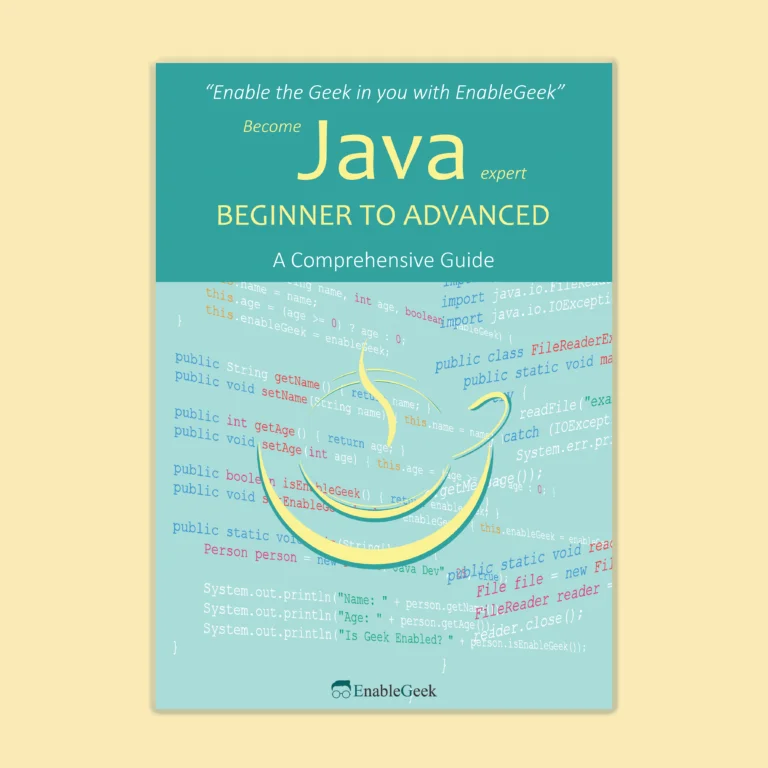Introduction to Strings in Java
Strings are one of the most fundamental and frequently used data types in Java programming. They represent sequences of characters and are used to store and manipulate text-based information. In Java, strings are instances of the String class, which is part of the java.lang package, and they offer a wide range of methods and operations for text manipulation.
Here are some key points to understand about strings in Java:
1. Text Representation: Strings are used to represent sequences of characters. Characters in Java are represented using the Unicode character set, which allows Java to handle characters from various languages and symbols.
2. Immutability: One of the unique characteristics of strings in Java is their immutability. Once a string is created, its content cannot be changed. This means that any operation that seems to modify a string actually creates a new string with the modified content. While this might seem inefficient, Java’s string manipulation operations are optimized to handle this behavior efficiently.
3. String Literal: A string literal is a sequence of characters enclosed in double quotes. For example, "Hello, Java!" is a string literal. Java automatically creates a String object to hold the content of a string literal. String literals are also automatically interned, meaning that Java maintains a pool of unique strings in memory to conserve memory usage.
4. Creating Strings: Strings can be created using constructors or string literals. For example:
String str1 = new String("Hello");
String str2 = "World";In most cases, using string literals is preferred, as it’s more concise and efficient.
5. Concatenation: You can concatenate strings using the + operator:
String greeting = "Hello" + ", " + "World";However, for efficient string concatenation, especially in scenarios where multiple concatenations are needed, it’s recommended to use the StringBuilder or StringBuffer classes.
6. Common String Methods: The String class provides a variety of methods for string manipulation, such as:
length(): Returns the length of the string.charAt(index): Returns the character at the specified index.substring(beginIndex, endIndex): Returns a substring between the specified indices.toUpperCase()andtoLowerCase(): Converts the string’s characters to uppercase or lowercase.indexOf(str): Finds the index of the first occurrence of a substring.startsWith(prefix)andendsWith(suffix): Checks if the string starts or ends with the specified substring.
7. Comparing Strings: Strings can be compared using the equals() method for content-based comparison and the compareTo() method for lexicographical comparison.
8. String Formatting: The String.format() method allows you to format strings using placeholders and format specifiers.
9. Regular Expressions: Strings can be matched against patterns using regular expressions, facilitated by the Pattern and Matcher classes.
In conclusion, understanding strings is essential for any Java programmer, as strings play a central role in almost every Java application. Their immutability, wide range of methods, and handling of text-based data make them a crucial tool for text manipulation and processing.
String Methods and Manipulation
String manipulation is a core aspect of programming, and Java’s String class provides a variety of methods to help you work with strings effectively. These methods allow you to extract, modify, and analyze the content of strings. Here’s an overview of some commonly used string methods and manipulation techniques in Java:
1. length() Method: The length() method returns the number of characters in a string.
String text = "Hello, World!";
int length = text.length(); // length will be 132. charAt(index) Method: The charAt(index) method returns the character at a specified index within the string.
char character = text.charAt(7); // character will be 'W'3. substring(beginIndex, endIndex) Method: The substring(beginIndex, endIndex) method extracts a portion of the string between the specified indices. The endIndex is exclusive.
String sub = text.substring(7, 12); // sub will be "World"4. Changing Case: The toUpperCase() and toLowerCase() methods allow you to convert a string’s characters to uppercase or lowercase.
String uppercase = text.toUpperCase(); // uppercase will be "HELLO, WORLD!"
String lowercase = text.toLowerCase(); // lowercase will be "hello, world!"5. Searching and Indexing:
- The
indexOf(str)method finds the index of the first occurrence of the specified substring. - The
lastIndexOf(str)method finds the index of the last occurrence of the specified substring.
int firstIndex = text.indexOf("o"); // firstIndex will be 4
int lastIndex = text.lastIndexOf("o"); // lastIndex will be 86. Checking Prefix and Suffix:
- The
startsWith(prefix)method checks if the string starts with the specified prefix. - The
endsWith(suffix)method checks if the string ends with the specified suffix.
boolean startsWithHello = text.startsWith("Hello"); // true
boolean endsWithWorld = text.endsWith("World!"); // true7. Trimming Whitespace: The trim() method removes leading and trailing whitespace characters from a string.
String spacedText = " Trim me! ";
String trimmedText = spacedText.trim(); // trimmedText will be "Trim me!"8. String Concatenation:
- The
+operator can be used to concatenate strings. - The
concat(str)method performs string concatenation.
String part1 = "Hello, ";
String part2 = "Java!";
String concatenated = part1 + part2; // concatenated will be "Hello, Java!"
String concatMethod = part1.concat(part2); // concatMethod will also be "Hello, Java!"9. Replace and ReplaceAll: The replace(oldStr, newStr) method replaces occurrences of oldStr with newStr
String replacedText = text.replace("World", "Universe");The replaceAll(regex, replacement) method replaces all occurrences that match the given regular expression.
10. Splitting Strings: The split(delimiter) method splits a string into an array of substrings based on the specified delimiter.
String csv = "apple,banana,orange";
String[] fruits = csv.split(",");
// fruits array will contain {"apple", "banana", "orange"}String Immutability and Memory Management
String Immutability and Memory Management
Understanding string immutability and memory management in Java is crucial for writing efficient and reliable programs. Strings are immutable objects in Java, which means that once a string is created, its content cannot be changed. This design choice has significant implications for memory management and the way strings are handled in your code.
1. String Immutability:
String immutability means that the contents of a string object cannot be modified after the object is created. When you perform operations on a string that appear to modify it, you’re actually creating new string objects with the modified content. This property has several benefits:
- Thread Safety: Immutable strings are inherently thread-safe, as they cannot be modified after creation. This simplifies concurrent programming.
- Caching and Reusability: Java uses a string pool (also known as the intern pool) to store unique string literals. This minimizes memory usage by reusing identical string objects.
- Security: Immutability helps prevent unintended changes to strings, which can be crucial for security-sensitive operations.
2. Memory Management:
String immutability and the use of the string pool have implications for memory management in Java:
- String Pool: When you create a string using a string literal, Java checks if an identical string already exists in the string pool. If it does, the existing string is reused, reducing memory overhead. This is known as string interning.
- Concatenation and Memory Usage: Concatenating strings with the
+operator creates new string objects, which can lead to memory fragmentation and inefficiencies when done excessively. To mitigate this, useStringBuilderorStringBufferfor more efficient concatenation. - Garbage Collection: Since strings are immutable, when you create a new string object from an existing one, the original string is not modified, and a new object is created. This can lead to more objects being created and eventually needing to be garbage collected.
3. Managing Memory Efficiently:
To manage memory efficiently when working with strings:
- Use StringBuilder or StringBuffer: When performing frequent concatenation or modifications to a string, use
StringBuilder(for single-threaded applications) orStringBuffer(for multi-threaded applications) to reduce unnecessary object creations. - Avoid Unnecessary String Object Creation: Be cautious when repeatedly creating strings in loops or methods. Consider using methods that work directly with character arrays or
StringBuilderto minimize unnecessary object creation. - Use String Pool Wisely: While string interning helps with memory efficiency, be mindful not to excessively intern strings, as it can lead to an unnecessary increase in the size of the string pool.
- Immutable Data in APIs: Design your APIs to use immutable strings when passing data. This ensures that the data remains unchanged during processing and avoids unexpected modifications.
In conclusion, understanding string immutability and memory management is crucial for writing performant and reliable Java programs. By leveraging the benefits of string immutability and using appropriate techniques for efficient memory usage, you can optimize the way your code handles string data and minimize unnecessary memory overhead.



